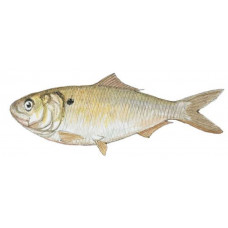Latin name
Brevoortia tyrannus
Other names
Pogy, bunker, bughead, bugfish, fatback, menhaden, mossbunker; Danish, Finnish, Norwegian, Polish, Swedish: menhaden; French: menhaden tyran; Spanish: lacha tirana.
Identification
The body is rather high, compressed from the sides. Head is large. Mouth is big, slanting. The end of the upper jaw goes behind the vertical of the hind margin of the eye or only just reach it. Scales on the body, large. Well pronounced speckled scales. He also has fatty eyelids that make him appear drowsy. It has a dark blue back, silvery flanks with a reddish or brass tint, pale yellow fins edged with black, a dark area on the shoulder, and two or three scattered rows of smaller spots.
Distribution
This species is found in the western Atlantic Ocean from Nova Scotia to the Indian River in southern Florida.
Habitat
A marine, gregarious pelagic fish that usually lives near shores. In the northern part of its range, it goes to greater depths in winter. Atlantic menhaden inhabit inland tidal brackish water and coastal saltwater areas. They migrate to bays and coves, and live in the coastal zone in summer.
Size
The largest known standard length is 50 cm. The Atlantic menhaden grows quickly: in the first year it reaches an average length of 13 cm, in the second year 21.5 cm, the third year 25.0 cm, the fourth year 29 cm. Atlantic menhaden can reach a length of 11⁄2 feet.
Life history and Behavior
Atlantic menhaden form large and very compact schools of both juvenile and adult fish, making them vulnerable to fishermen. The menhaden have clear seasonal migrations - northern in April and May and southern in early fall. Spawning occurs year-round, although not in the same places at the same time. For example, because high water temperatures are detrimental to reproduction, the peak of spawning off the southern U.S. coast occurs between October and March. The number of eggs in each female ranges from tens of thousands to hundreds of thousands. They swim freely and hatch out to sea. After hatching, the offspring are transported to estuaries and bays that serve as protected feeding areas where juvenile Atlantic menhaden spend their first year. The fish become sexually mature between the first and third year of life.
Food and feeding habits
The food consists of phytoplankton and zooplankton (mainly copepods). Algae and detritus are also noted in the food composition. The Atlantic menhaden filters small plants and animals from the water using long filaments on its gills.
Reproduction
Spawns at sea, in the northern part of the range from June to August, in the south - in late fall and winter (in October-November in Cape Cod and Long Island, from December to March - off Florida).
| Classification | |
| Phylum | Chordata |
| Class | Actinopterygii |
| Squad | Clupeiformes |
| Family | Clupeidae |
| Genus | Brevoortia |
| Species | B. tyrannus |
| Features | |
| Conservation status | Least Concern |
| Habitat | Pelagic |
| Life span, years | 12 |
| Maximum body weight, kg | 1.2 |
| Maximum length, cm | 50 |
| Sailing speed, m/s | No information |
| Threat to people | Edible |
| Way of eating | Predator |





